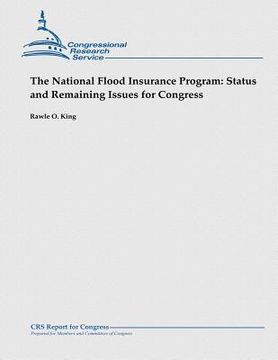The National Flood Insurance Program: Status and Remaining Issues for Congress (en Inglés)
Reseña del libro "The National Flood Insurance Program: Status and Remaining Issues for Congress (en Inglés)"
On October 29, 2012, Hurricane Sandy struck the East Coast region, causing intense winds, high rainfall, waves, and storm surge, as well as economic disruptions in states throughout the Northeast and the mid-Atlantic region. Communities in New York, New Jersey, and Connecticut were particularly hard hit. The devastating floods exposed vulnerabilities in the region's public transportation and infrastructure and underscores the nation's growing exposure to coastal hazards. The full economic cost of Sandy will not be known for years, but current preliminary estimates of physical property damage, not including flood losses likely to be paid under the government's National Flood Insurance Program (NFIP), range from $30 billion to $55 billion, of which about $16 billion to $22 billion will be privately insured losses. Sandy is expected to require substantial federal disaster recovery assistance, including tens of billions for flood and hurricane protection and coastal restoration. Given the geographic scope of heavily flooded areas and residential take-up rates (number of flood policies divided by total number of households) in affected coastal communities that participate in the NFIP, government payouts under the NFIP are estimated to be from $12 billion to $15 billion in flood claims. This amount exceeds the $4 billion in cash and remaining borrowing authority from the Treasury Department. The Obama Administration has announced it will ask Congress to raise the NFIP borrowing authority to $25 billion, or $4.025 billion over its current borrowing authority. But some experts have suggested a $30 billion borrowing cap would be needed to cover even higher projected losses. Emergency supplemental spending on disaster assistance comes at a time when Congress is considering spending cuts and tax increases to address the nation's fiscal debt. In the wake of disaster clean-up and recovery along much of the East Coast region, policymakers, local officials, and other stakeholder groups have expressed a range of flood management concerns facing the NFIP. These include (1) escalating spending on federal emergency supplemental appropriations for disaster relief assistance; (2) uncertainty surrounding the NFIP's ability to reduce the nation's growing exposure to flood losses; (3) rising population growth and economic development in coastal watershed counties or floodplains areas exposed to hurricane induced coastal floods; (4) persistently low insurance participation (take-up rates) in the NFIP; and (5) financing the cost of rebuilding communities stronger, more resilient. On July 6, 2012, President Obama signed into law the Biggert-Waters Flood Insurance Reform Act of 2012, P.L. 112-141, that reauthorized the NFIP through September 30, 2017, and made a number of reforms to strengthen the future financial solvency and administrative efficiency of the program by raising historically low premiums and reducing homeowners' incentives for rebuilding in flood risk zones. However, several post-reform issues of contention remain for congressional consideration: revisions in the analysis and mapping of non-accredited levees; actuarial soundness, program solvency, and affordability; debt forgiveness; an integrated watershed flood risk assessment framework; and expansion of the private-sector role in flood risk. This publication provides an analysis of flood risk management, summarizes major challenges facing the NFIP, and outlines key reforms in the recently enacted Biggert-Waters Flood Insurance Reform Act of 2012. The publication also identifies and presents some key remaining flood management issues for congressional considerations, and it concludes with a discussion of relevant policy options for the future financial management of flood hazards in the United States.

